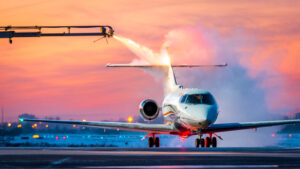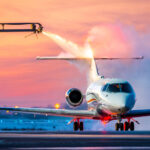Flying through mountain passes can provide a unique and exciting experience for travelers…and pilots. With the right planning, pilots can safely navigate their way around terrain that may be difficult to traverse in other types of transportation.
The Journey is Half the Fun When Flying Through a Mountain Pass
When it comes to aviation safety, there are some important points to keep in mind when flying over a mountain pass.
First, you’ll need to make sure that your aircraft can handle the terrain and weather conditions associated with mountain passes. This means having an up-to-date weather report as well as checking the instrument panels for any signs of malfunctions or problems. You’ll also want to be aware of any potential obstacles such as rocks or trees that could pose a risk during your flight.
Performance, Density Altitude, and Departure/Arrival Procedures
Aircraft performance is critical when flying in mountainous areas. You should be aware of your aircraft’s power capabilities, rate-of-climb limitations and fuel consumption ratios at altitude since oxygen levels decrease, which can cause problems with fuel systems if not accounted for. Additionally, temperatures affect pressurization systems causing cabin altitude issues if not closely monitored by instruments inside the cockpit. To minimize the risk of engine failure or other issues arising due to reduced air density at high altitudes – also known as density altitude – it is important for pilots to understand how temperature, pressure and humidity interact and how to adjust takeoff speeds accordingly to compensate for reduced engine power at increased elevations.
It is also imperative you are familiar with normal departure and arrival procedures when flying around mountains. Departing from high altitudes requires particular care, as steep climbs must be done slowly; thus making sure altitude gains are made steadily with sufficient road clearance throughout the process. On arrival into mountain mountains, a shallow descent should be executed – again taking care to maintain adequate visibility while avoiding any sudden changes in attitude or heading.
Wind Speeds and Altitudes
It’s also important to be aware of the winds in order to maintain a safe and comfortable flight. You may need to adjust your speed or altitude depending on the wind direction and strength. Additionally, you’ll want to keep an eye out for turbulence as it can be more intense when passing through mountain passes.
When selecting the correct speed for their aircraft it is important to consider all potential hazards that could arise. The heavier an aircraft is, the lower its stall speed will be; therefore when flying at high altitudes where air density is decreased this must be taken into account to ensure sufficient lift is achieved during takeoff. Additionally, wind direction and speed should be taken into consideration; strong headwinds require faster airspeeds while tailwinds should be avoided altogether or if unavoidable then countered with a higher groundspeed.
Much like speed selection, altitude choice requires careful evaluation of potential risks before any decision is made. Weather forecasts should always be consulted to avoid hazardous conditions such as thunderstorms or icing; additionally mountainous terrains may impose restrictions on airspace vertical limits and indicate areas where turbulence can form – either over ridges or within low-level wind shears – both of which should be navigated carefully when encountered in-flight. Finally, clouds can reduce visibility significantly and although higher altitudes offer more options for flying around them smaller aircrafts may not have enough power to ascend quickly enough to clear any possible mountainside cloud layers; thus making accurate preflight preparation essential prior to setting out on any journey involving mountain passes.
Navigating
In terms of navigation, having a GPS is essential for flying over mountain passes. You should also allow yourself plenty of time to try different routes so that you can find the best possible trajectory with no unexpected surprises along the way.
Finally, if you’re feeling nervous about flying through a mountain pass, don’t hesitate to get some additional help from experienced pilots or flight instructors. Having a second pair of eyes on board is always beneficial when navigating unfamiliar terrain. With these tips in hand, you’ll be ready to take your business jet aircraft through mountain passes with confidence!
Conquer the Peaks
Safety when flying through a mountain pass is important. So, we’ve come up with a top 10 list of tips to help you and your flight conquer the peaks:
- Increase situational awareness: Pilots should always be aware of their surroundings and the potential hazards they may face while flying in mountainous regions.
- Plan alternate routes and landing sites: Before embarking on a flight, pilots should plan alternate routes and landing sites in case their primary route is inaccessible due to hazardous conditions or terrain.
- Monitor altitude levels: Mountainous terrain can make it difficult to accurately gauge altitude levels, so pilots should always be aware of their location in relation to mountains peaks.
- Describe potential hazards to ATC: Pilots should advise ATC of any potential hazards they may encounter while flying such as turbulence, limited visibility, or other dangerous weather patterns.
- Check aircraft systems regularly: During mountainous flights, pilots should check aircraft systems regularly to ensure everything is functioning properly and no issues are present that could lead to a dangerous situation.
- Use caution when descending/ascending: Pilots should use extreme caution when ascending or descending over mountainous regions as this can increase turbulence and put additional stress on the aircraft structure.
- Be aware of airframes icing up at high altitudes: When flying at higher altitudes, aircraft are more susceptible to ice accumulation which can affect performance and operation if uncorrected.
- Stay clear from clouds or precipitation: Pilots should remain clear from clouds or precipitation in order to avoid hazardous conditions such as icing or thunderstorms which can disrupt flight plans significantly.
- Maintain communication with ground personnel: Pilots should always maintain communication with ground personnel in order to ensure there are no changes or alterations along the planned route of travel that could disrupt the mission objectives.
- Have an emergency plan in place: Prior to takeoff, pilots should familiarize themselves with onboard safety equipment and procedures as well as alternative routes or destinations in case of adverse weather conditions before beginning a flight over mountain regions
Remember to stay mindful of aviation safety tips and use all available resources for optimal success. Be sure to plan, check for any malfunctions or obstacles, adjust your speed based on wind strength and direction, and use a GPS for navigation. With these tips in mind, you’ll be ready to tackle even the most challenging mountain passes with confidence. With careful planning and preparation, you can have a safe and enjoyable experience.
CTS provides training packages and courses designed for avoiding collisions into terrain. Feel free to email us at train@www.ctsys.com and let our team curate a training package to suit your company’s needs.
RELATED READING
RELATED CTS TRAINING









